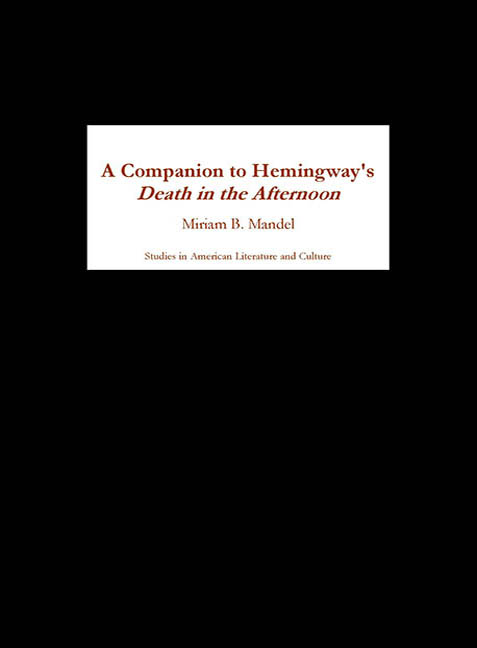Book contents
- Frontmatter
- Dedication
- Contents
- Acknowledgments
- Hemingway Works That Address the Bullfight
- A Note on the Text of Death in the Afternoon
- Introduction
- Composition, Sources, and Backgrounds
- Reading Texts, Paratexts, and Absence
- On Authorship and Art
- “Prejudiced through Experience”: Death in the Afternoon and the Problem of Authorship
- “The Sequence of Motion and Fact”: Cubist Collage and Filmic Montage in Death in the Afternoon
- And What Came After
- Works Cited
- Notes on the Contributors
- Index
“Prejudiced through Experience”: Death in the Afternoon and the Problem of Authorship
from On Authorship and Art
Published online by Cambridge University Press: 27 April 2017
- Frontmatter
- Dedication
- Contents
- Acknowledgments
- Hemingway Works That Address the Bullfight
- A Note on the Text of Death in the Afternoon
- Introduction
- Composition, Sources, and Backgrounds
- Reading Texts, Paratexts, and Absence
- On Authorship and Art
- “Prejudiced through Experience”: Death in the Afternoon and the Problem of Authorship
- “The Sequence of Motion and Fact”: Cubist Collage and Filmic Montage in Death in the Afternoon
- And What Came After
- Works Cited
- Notes on the Contributors
- Index
Summary
All art is only done by the individual.
Death in the Afternoon, 99[I]t is always a mistake to know an author.
Death in the Afternoon, 144The critic, out on a limb, is more fun to see than a mountain lion.
Ernest Hemingway, “Interview,” 58InDeath in the Afternoon, Ernest Hemingway locates public, or published, art within a discursive matrix that is at once individual, artistic, aesthetic, professional, social and cultural. He insists that “All art is only done by the individual” (99), but admits the matrix as a necessity without which art cannot reach its publics. On nearly every page he critiques this matrix for the decadent compromises it works on art and its participants. In Death in the Afternoon, Hemingway metacritically argues that bullfighting — and, by analogy, any published art form — comprises a symbiotic dialogue between an artist and the public. This dialogue consists of the exchange of fiscal, cultural, and critical capital; the nature of the exchange inevitably, Hemingway insists, introduces mutations to the art form and to the artist. Against such mutations he proposes knowledge: specifically, an educated public.
Death in the Afternoon's Author / Old lady dialogues are central to Hemingway's metacritical and pedagogical agendas. In these dialogues, Hemingway deconstructs the discursive exchange between an artist and art's publics to illustrate the dangers intrinsic to that exchange. He first illustrates how his narrator, a writer, becomes additionally a character named “Author” through interaction with a lowest-common-denominator public (personified by another character, the Old lady). He then instructs his readers to judge the Author's product as lacking in quality when compared to that of the narrator. Within Hemingway's logic, writer and author are necessarily connected but not synonymous: the writer is the individual artist, someone who does, whereas authorship is a professional role, distinguishable from the writer by being no less a product of writing than are the characters that the writer creates. When Hemingway began writing Death in the Afternoon, he was already aware of the extent to which he was becoming a brand name author (a condition he would both court and resist for the rest of his career), and he had begun to glimpse how potentially detrimental the interest created by his public persona might be to his private writerly self, to his writing, and to his readers’ experience of that writing.
- Type
- Chapter
- Information
- A Companion to Hemingway's Death in the Afternoon , pp. 237 - 256Publisher: Boydell & BrewerPrint publication year: 2004

